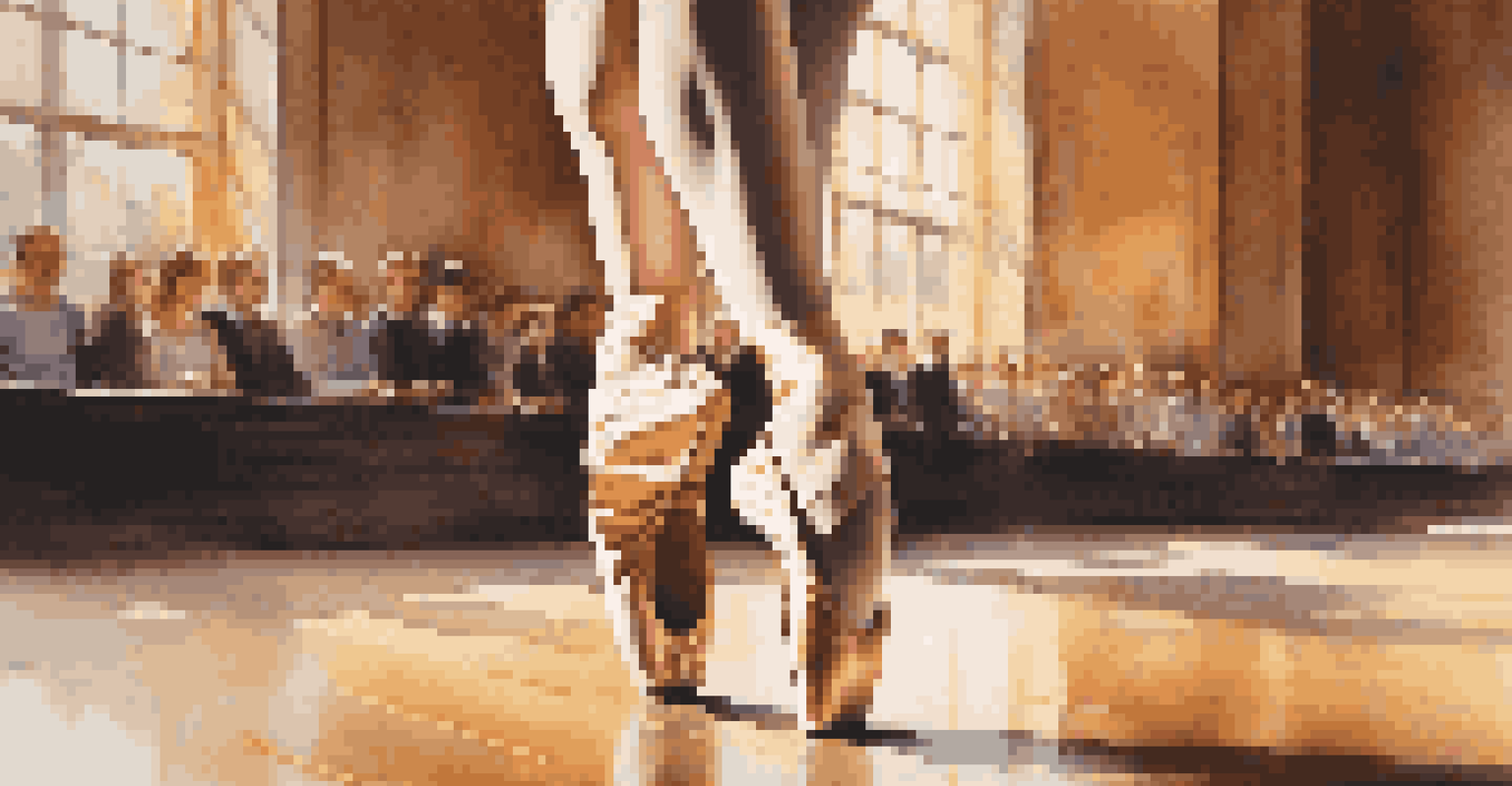Music's Emotional Impact: How It Shapes Dance Performance

The Connection Between Music and Emotion
Music has a unique ability to evoke emotions, and this connection is vital in dance. When dancers perform, the music they choose becomes the backdrop for their emotional expression. For instance, a slow, melodic piece can bring out feelings of longing and sadness, while an upbeat track might inspire joy and energy.
Music can change the world because it can change people.
This emotional resonance is not just felt by the dancers; it’s palpable in the audience too. People often connect with the performance on a deeper level when they can relate to the emotions conveyed through both music and movement. It’s this synergy that makes a dance truly memorable.
Moreover, the emotional impact of music can guide a dancer's technique and style. The tempo, rhythm, and dynamics of a piece can dictate how a dancer interprets each movement, creating a cohesive narrative that speaks to the heart.
How Rhythm Influences Dance Movements
Rhythm serves as the heartbeat of any dance performance, dictating the pace and flow of movements. Dancers often rely on the underlying beat of the music to synchronize their steps, ensuring their movements feel natural and fluid. Consider how a quick, staccato rhythm invites sharp, precise movements, while a flowing melody encourages more graceful, sweeping gestures.

This rhythmic connection is so crucial that dancers often spend hours training to internalize different musical styles. By doing so, they learn to interpret and express music through their bodies, making each performance a unique experience. It’s like having a conversation with the music, where every beat has its own story to tell.
Music Evokes Deep Emotions in Dance
The connection between music and emotion is vital, allowing dancers to express feelings that resonate with both themselves and their audience.
Additionally, variations in rhythm can lead to dynamic changes in a performance. A sudden shift from a slow tempo to a fast beat can create dramatic tension, captivating the audience and enhancing the overall emotional experience.
The Role of Melody in Expressing Feelings
Melody is the soul of music, often carrying the primary emotional weight. In dance, a strong melody can guide a dancer’s expression, shaping the narrative they convey through their movements. For example, a soaring melody might inspire expansive, uplifting movements, while a dissonant one could evoke tension and conflict.
Dance is the hidden language of the soul.
Dancers often interpret melodies in personal ways, tapping into their own experiences to bring authenticity to their performance. This personal connection can make each piece feel unique, as the dancer infuses their own emotions into the choreography.
Moreover, the ability to seamlessly blend melody with movement allows dancers to connect with their audience on a profound level. When a dancer embodies the essence of a melody, it creates a shared emotional experience, fostering empathy and resonance among spectators.
Using Dynamics to Enhance Performance
Dynamics in music refer to the variations in volume and intensity, and they play a crucial role in dance performance. Dancers use dynamics to amplify their movements, making certain moments more impactful. A sudden crescendo can lead to an explosive leap, while a soft decrescendo might prompt a gentle, flowing gesture.
This interplay between music dynamics and dance creates an engaging visual experience. For instance, a dancer may choose to punctuate a powerful musical peak with a dramatic pose, drawing the audience’s attention and evoking a strong emotional response.
Rhythm Shapes Dance Movements
Rhythm serves as the heartbeat of dance, guiding the pace and style of movements, and creating a dynamic interplay between music and performance.
By mastering the use of dynamics, dancers can enhance their storytelling. The ability to match their movements to the fluctuations in music allows them to create a richer, more nuanced performance that resonates deeply with viewers.
Cultural Influences on Music and Dance
Music and dance are deeply rooted in cultural traditions, influencing how emotions are expressed. Different cultures have unique musical styles that evoke specific feelings and movements. For example, a traditional flamenco piece may inspire passionate, sharp movements, while a waltz encourages smooth, flowing steps.
Dancers often draw from their cultural backgrounds to enrich their performances, adding layers of meaning through their interpretations. This cultural infusion not only highlights their individuality but also promotes a broader understanding of diverse emotional expressions.
Additionally, the integration of various cultural influences in dance performances can foster a sense of unity. When dancers incorporate music from different traditions, it creates an opportunity for cross-cultural dialogue, allowing audiences to appreciate the shared human experience of emotion.
The Psychological Impact of Music on Dancers
The psychological effects of music are profound and can significantly impact a dancer's performance. Upbeat music can boost motivation and energy levels, while slower music may help in focusing and calming nerves. Dancers often select specific tracks to help them get into the right mindset before a performance.
Moreover, music can serve as a tool for emotional regulation. For instance, a dancer feeling anxious may listen to soothing melodies to calm their nerves, while someone looking to channel raw energy may opt for a powerful, fast-paced track. This ability to manipulate emotions through music is an essential skill for performers.
Cultural Influences Enrich Dance
Cultural traditions infuse unique emotional expressions into music and dance, promoting individuality and fostering cross-cultural appreciation.
Ultimately, the psychological relationship between music and dance not only enhances individual performances but also contributes to the overall atmosphere of a performance. When a dancer feels connected to the music, it translates into a more authentic and captivating experience for the audience.
The Future of Music and Dance Collaboration
As the world evolves, so does the collaboration between music and dance. New technologies, such as digital music production and interactive performances, are expanding the possibilities for artistic expression. Dancers are increasingly experimenting with various genres, blending classical styles with contemporary beats to create innovative works.
This fusion of styles not only challenges traditional boundaries but also invites a diverse audience to engage with dance in new ways. By embracing different musical influences, dancers can reach wider demographics, fostering a deeper appreciation for the art form.

Looking ahead, the relationship between music and dance will continue to evolve, driven by creativity and cultural exchange. As artists push the envelope, we can expect to see exciting new collaborations that further explore the emotional impact of music in dance performance.